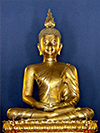|
Angkhirot (อังคีรส)
Thai. Name of a Buddha statue, housed at the
ubosot of
Wat Ratchabophit (fig.)
in
Bangkok. According to
Somdet
Phra
Ariyawongsaagatanyaana (อริยวงศาคตญาณ),
the 20th
Supreme Patriarch
of Thailand and the former abbot of Wat Ratchabophit, the name means ‘to have a ray of light emanating from the body’. The Angkhirot statue, cast under the royal initiative of King
Rama IV, is a special form of Buddha, with special characteristics, in this, that it does not have an
ushnisha or ketumala (fig.), i.e. the protuberance normally found on the head of a Buddha image, as one of the marks of an enlightened being in Buddhist
iconography, and which in Thailand is usually topped by a lotus bud (fig.) or a flame called
rasmie, that emerges from this bump, as a symbol of
Enlightenment. When King Mongkhut (fig.), that is Rama IV, was ordained as a monk, he read in some manuscripts that this ketumala or bump arose through the power of concentration during meditation. Yet, he was not in favour of this feature being incorporated in every depiction of the Buddha for reasons of esthetics and hence had a small number of Buddha statues cast without a ketumala, with the flame or rasmie placed directly on top of the head. These statues are distinct of other Buddha images of that period, and were cast as prototypes of Buddhist art in the royal style of that era, including Phra Angkhirot, Phra Nirantarai (พระนิรันตราย), and Phra Samphutthasiri (พระสัมพุทธสิริ). The Angkhirot Buddha statue is cast in bronze with a slightly round face, shorter than usual ─almost human-like─ earlobes, and wearing his winter cloak, i.e. a large sheet like the actual
sangkaathi cloth used by ordinary monks on their robes, folded over the left shoulder. Later, King
Chulalongkorn, that is
Rama V, donated gold in excess of 180
baht that he received at his Investiture during the Royal Tonsure Ceremony, to have the statue plated with eight layers of gold. This made the statue shine with so much splendor, that it was given the name Angkhirot, i.e. ‘having a ray of light emanating from the body’.
See also POSTAGE STAMP.
回






|

